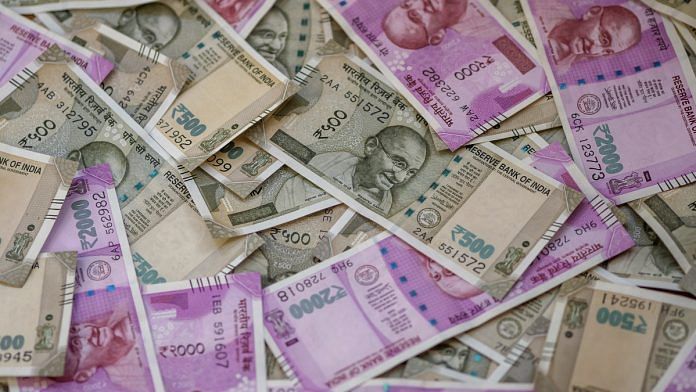New Delhi: In a latest research, scientists from CSIR-National Physical Laboratory (NPL) in New Delhi have come up with a security ink — which can prevent duplication of printable documents and counterfeiting of currency notes.
The research, published in the Journal of Materials Chemistry C in October, was conducted on the principle of the fluorescence-phosphorescence technique, which emits two colours on the excitation of a single wavelength.
The two colours are red and green — red at 611 nanometre (nm) is due to fluorescence, and the green at 532 nm is from the phosphorescence effect.
“The advanced security feature of the ink comes from its change of pigment colour. Currently, the currency notes display only a single colour with the emission of wavelength,” said Dr Bipin Kumar Gupta, senior scientist at the NPL, who led the team of researchers.
“In the ambient light, the ink showcases white colour. When exposed to UV (ultraviolet) light at 254 nm, it changes the colour to red and when the UV source is switched off, it turns green,” he added. The colors can be seen through naked eyes.
According to researchers, the technique of dual emissive luminescent pigment for security purposes is the first-of-its-kind and never used for printing of notes or confidential documents.
Counterfeiting of currency notes
According to the Reserve Bank of India’s (RBI) annual report 2018-19, the new Rs 500 and Rs 2,000 notes introduced after demonetisation are at the risk of duplication.
According to the report, the duplication of a new design of Rs 500 notes is accounted to be 121 per cent and of Rs 2,000 notes to be 21.9 per cent during 2018-2019. The report also stated that about 12,728 counterfeit notes of the Rs 200 currency note, introduced in 2017, were detected.
The currency notes are embedded with about 10 security features, including a three-dimensional watermark, micro lettering, security threads and colour shift pattern.
Also read: Fake banknotes seized in India doubled after demonetisation, Gujarat topped list: NCRB
Dual emissive luminescent security ink
The main task of the team was to select compounds, which do not obstruct the formation of the colours on the excitation of the wavelength.
For the production of luminescent pigment, two chemical compounds — sodium yttrium fluorite, europium-doped and strontium aluminate with europium-dysprosium — were synthesised to emit red and green colours, respectively.
The fluorescence property is through sodium yttrium fluorite, while the phosphorescence is by compound strontium aluminate.
The NPL researchers used the hydrothermal synthesis method to get the red colour. In hydrothermal synthesis, a compound is crystallised from an aqueous solution at a high temperature.
To get the desired features of the ink, the two pigments were admixed at a weight ratio of 3:1. The mixture was then sintered for three hours at a temperature of 400°C. The heating process is also known as annealing. This resulted in the development of fine white powder for the single excitable dual emissive luminescent pigment. In addition, the heating process was done to ensure that the pigments stick to each other when the ink is produced.
“If we directly perform the mixing of both the phosphors (pigments) without annealing, then the individual pigments separate during ink formation and the required property of the ink to emit dual-colour is not developed,” Amit Kumar Gangwar, one of the authors of the study, told ThePrint.
In the last step, the powder was mixed with the polyvinyl chloride (PVC) medium to procure luminescent security ink.
“For the feasibility test of the ink, an image was printed on a non-fluorescent white bond paper using a standard screen printing technique. The results showcased the emission of red and green colours under the 254 nm UV excitation when the source was turned on and off,” said Dr Gupta.
Properties and applications
To analyse the stability of the ink, the researchers conducted chemical tests with various bleaching agents like soap solution, ethyl alcohol and acetone.
“We studied the durability of the ink for about six months under rigorous atmospheric conditions like humid, hot and cold. Under all conditions, it remained stable, with no changes in print quality,” said Girja Shankar, another author of the study, who monitored the ink properties.
In addition, the viscosity of ink was tested for better printing quality. It was done on both screen and offset printing to ensure the pigment properties.
Apart from solving the problem of counterfeiting of currency notes, the novel ink can be used in printing documents, which have a high risk of security breach and duplication.
For example, the passport cover when seen under the UV light showcases covert emblem of India in green colour. With the new ink, it will emit two colours, which is hard to copy.
It can also be used in the pharmaceutical sector where drug companies can protect the medicines from being duplicated by printing the security features through this ink. This will ensure that there is no change in the composition of the product and that consumers get the authentic drug.
The security feature of the luminescent ink can be used in legal confidential certificates, merchandise and electronic barcodes also to avoid duplication or sale of fake products.
Mrigakshi Dixit is a freelance science journalist based out of New Delhi.
Also read: No end to fake notes problem, data shows huge jump in counterfeit Rs 500 & Rs 2,000






